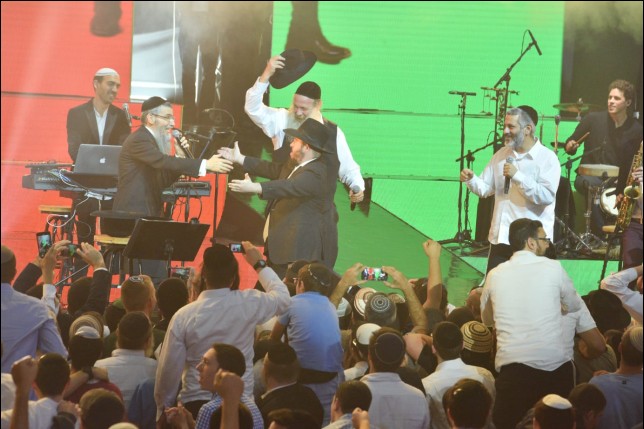Rabbi Menachem Brod: "19th of Kislev is Not Just for Chassidim"
Why is 19th of Kislev considered the 'Rosh Hashanah of Chassidus'? What happened on this day and how has it impacted the spread of Chassidus over the generations? Rabbi Menachem Brod explains and answers all questions.
 Events of 'Tzama' at Binyanei Hauma
Events of 'Tzama' at Binyanei HaumaDid you also go out today, Tuesday, the 19th of Kislev, and encounter people dressed in festive clothes? Did your neighbor shake your hand and wish you: "Happy Holiday"?
The date of the 19th of Kislev has been celebrated for years under the title 'Rosh Hashanah of Chassidus', but it turns out not everyone knows what truly underlies it, and what causes Chassidus to mark this specific day with great excitement. To understand things a bit more deeply, we went to talk to Rabbi Menachem Brod.
A Revealed and Hidden Day
Rabbi Brod, what exactly is the 19th of Kislev?
"When we look at Judaism in general, we can see that every event marked has its physical meaning and, conversely, its spiritual meaning," explains the rabbi, "and it's important to emphasize that the physical event does not always reflect the spiritual meaning.
"If we talk about the physical aspect of the 19th of Kislev, it's the day Rabbi Shneur Zalman of Liadi, author of the Tanya and founder of Chabad Chassidus, was released from imprisonment. This happened after he was held in the fortress of the then capital, Petersburg, because he was accused of rebellion against the monarchy. The author of the Tanya was in prison for 53 days, and on the 19th of Kislev he was released. It's undoubtedly a huge event, but as we all know—over the years, there have been many dramatic cases of rabbis and rebbes being imprisoned. Sometimes they were released, and in other cases, they remained in prison. The thing is, this event is entirely different from other incidents."
What is so different about this event?
Rabbi Brod clarifies: "We must understand that the author of the Tanya viewed his imprisonment as a reflection of accusation in the higher worlds for spreading Chassidus beyond how it had been recognized until then. Until those days, Chassidus was recognized only in the way the Baal Shem Tov and the Maggid of Mezeritch spread it, meaning in a relatively limited way.
"If we look at the contribution of the Baal Shem Tov and his disciple the Maggid of Mezeritch to Chassidus, we'll see delightful ideas and wondrous illuminations. Still, these are things that we, as simple people, do not entirely understand them and their depth. Only someone with deep knowledge of revealed and hidden Torah can understand the profound meanings embedded in the teachings of the Baal Shem Tov and the Maggid, whose passing also occurred today—the 19th of Kislev.
"In contrast, when Rabbi Shneur Zalman of Liadi wrote the Tanya and began saying Chassidic discourses that elucidate the matters of Chassidus and its inner dimensions, he effectively caused that everyone could understand the depth of the matters. It was a new kind of revelation that allows any person, regardless of their level, to experience Chassidus. The author of the Tanya feared that accusations in the heavens were arising since there would be claims that 'the glory of Hashem is to conceal a matter', and these exalted and sublime things should not be opened to everyone. After all, for thousands of years, such matters were traditionally transferred from rabbi to student, known as the hidden Torah, so how can this exposure be suddenly allowed?"

Rabbi Shneur Zalman of Liadi, of blessed memory (Illustration: Hila Ben Yitzhak)
Rabbi Brod, let's talk simply and understandably—what did the author of the Tanya innovate?
"It's fitting to take this opportunity to explain what Chassidus is. Because in essence, we have the Torah, and the Torah tells us, for example, how to lay tefillin and what kosher tefillin are. But the internal meaning of the tefillin, and what happens to me when I lay them, is something the Talmud does not speak of and the Shulchan Aruch does not discuss. These explanations can be found only in the inner dimensions of the Torah, such as in the Zohar and books of Kabbalah. The inner dimension of the Torah is called in the holy Zohar 'Neshmata d'Orayta', because just as a person has a body and a soul, so too does the Torah have a body and a soul. The body of the Torah is its revealed part, and the soul of the Torah is the inner and hidden part. It's crucial to emphasize—Chassidus is not Kabbalah, though it uses ideas and terminology from Kabbalah. It essentially expresses the soul of the Torah.
"Therefore, it's customary to say that the revelation of Chassidus in the time of the Baal Shem Tov brought about an awakening of the light of the Mashiach. Although young children are always told that 'when the Mashiach comes, candies will grow on the trees', anyone who studies these matters in-depth knows that when the Mashiach comes, the main thing will be 'the earth will be filled with the knowledge of Hashem'. There will be a revelation of Divine holiness."

"Not Hunger for Bread Nor Thirst for Water"
"As I mentioned," continues Rabbi Brod, "the Baal Shem Tov revealed things in a somewhat limited way, and so did his student the Maggid of Mezeritch. When the author of the Tanya came, he essentially opened the gates of the Torah to everyone, so that even a woman who opens Chassidic texts and a person without any Torah background can understand the inner dimensions of the Torah, and for this he feared arousing accusation that the time had not yet come.
"On the date of the 19th of Kislev," Rabbi Brod emphasizes, "the author of the Tanya was released from his imprisonment and saw it as a sign from heaven that from now on it's possible to spread the inner dimension of the Torah without restrictions. Indeed, it's possible to observe that after his release, the Chassidic discourses became longer, more explanatory, and broader, as he received the 'green light' to reveal and disseminate. Therefore, the 19th of Kislev became a festive day for Chassidus, much like on Shavuot when Hashem brought the Torah down from the heavens and gave it to us. Similarly, the 19th of Kislev is the day Hashem gave us the inner dimension of the Torah."
People associate this date primarily with Chabad Chassidus, but according to what you're saying, it pertains to all Chassidus.
"That's very true, it's a day celebrated by all the Chassidic groups, not just Chabad, and I'm sure I'm not surprising anyone by saying that there are also many people from broader circles in the Torah world, not necessarily Chassidic, who celebrate and mark it. I can share about my uncle who was a student of Rabbi Shteinman of blessed memory still in Hadera, which means about 60 years ago. Even back in those years, Rabbi Shteinman was asked if it was worthy to travel to a gathering near Kfar Chabad, and the rabbi definitely encouraged and recommended it, saying it would strengthen divine service. In recent years, I see a significant trend of marking this day across all sectors. There are many Jews who feel the need to participate in the events and gatherings on the 19th of Kislev."

In conclusion, Rabbi Brod mentions the special week of lectures currently taking place at the International Convention Center in Jerusalem. "It's a sight not often seen—many Jews from all strata and factions come to participate in gatherings and hear lectures on Chassidus subjects. You can see there Chassidim and Litvaks, religious nationalists and Sephardim, from all communities and groups, all coming together, happy, dancing, learning, listening, and loading up carts with Chassidic books. My personal feeling when I see this, is that the words of the verse are being fulfilled before our eyes: 'Not hunger for bread nor thirst for water, but to hear the words of Hashem.'"

